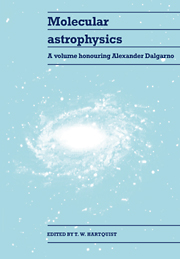Book contents
- Frontmatter
- Contents
- Dedication
- Preface
- Part I Molecular clouds and the distribution of molecules in the Milky Way and other galaxies
- Part II Diffuse molecular clouds
- 3 Diffuse cloud chemistry
- 4 Observations of velocity and density structure in diffuse clouds
- 5 Shock chemistry in diffuse clouds
- Part III Quiescent dense clouds
- Part IV Studies of molecular processes
- Part V Atomic species in dense clouds
- Part VI H2 in regions of massive star formation
- Part VII Molecules near stars and in stellar ejecta
- Part VIII Moderately ionized gas and chemistry at large redshifts
- Index
5 - Shock chemistry in diffuse clouds
Published online by Cambridge University Press: 10 December 2009
- Frontmatter
- Contents
- Dedication
- Preface
- Part I Molecular clouds and the distribution of molecules in the Milky Way and other galaxies
- Part II Diffuse molecular clouds
- 3 Diffuse cloud chemistry
- 4 Observations of velocity and density structure in diffuse clouds
- 5 Shock chemistry in diffuse clouds
- Part III Quiescent dense clouds
- Part IV Studies of molecular processes
- Part V Atomic species in dense clouds
- Part VI H2 in regions of massive star formation
- Part VII Molecules near stars and in stellar ejecta
- Part VIII Moderately ionized gas and chemistry at large redshifts
- Index
Summary
Introduction
The high observed column densities of CH+, one of the first identified (Douglas and Herzberg 1941) interstellar molecules, and of CO apparently indicate that existing static, equilibrium models do not provide adequate descriptions of the natures of diffuse molecular interstellar clouds. (See Chapter 3.) It has been argued that velocity structures in lines formed in such clouds provide evidence for the existence of shocks in them (e.g. Crutcher (1979), but see the detailed assessment by Langer in Chapter 4). If such shocks do exist, they will drive the production of detectable column densities of a number of chemical species.
The chemistry in shocked gas can be exceptionally rich since many reactions which, because they are endothermic or have activation barriers, are unimportant in cool, static gas, can proceed in shocked gas. For instance, the endothermic reactions C+ + H2 → CH+ + H (Elitzur and Watson 1978a) and S+ + H2 → SH+ + H (Millar et al. 1986) can initiate hydrogen abstraction sequences in shocked gas but are unimportant in static, cool diffuse clouds. A neutral–neutral sequence (Aannestad 1973) which is of no relevance to low temperature chemistry but which plays a major role in shock chemistry is O + H2 → OH + H; OH + H2 → H2O + H. The fractional abundances of CH+ and OH are high in some diffuse cloud shocks, and SH+ may serve as a diagnostic of shocks.
Collisionally induced rotational excitation of molecular hydrogen can also occur in diffuse cloud shocks.
Information
- Type
- Chapter
- Information
- Molecular AstrophysicsA Volume Honouring Alexander Dalgarno, pp. 99 - 112Publisher: Cambridge University PressPrint publication year: 1990
Accessibility standard: Unknown
Why this information is here
This section outlines the accessibility features of this content - including support for screen readers, full keyboard navigation and high-contrast display options. This may not be relevant for you.Accessibility Information
- 15
- Cited by
